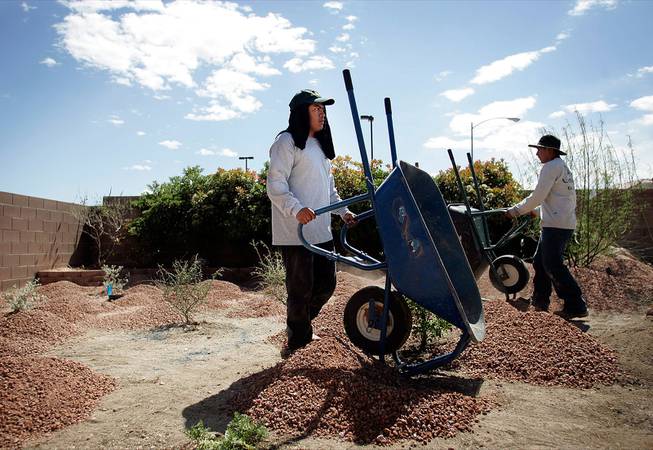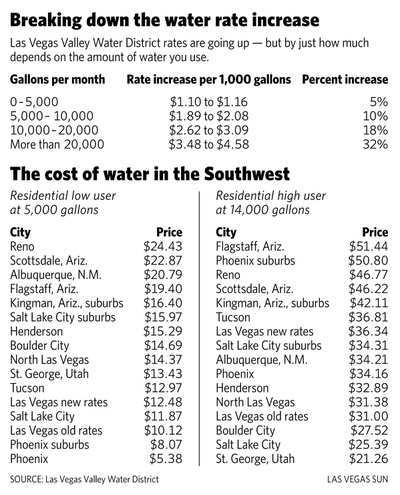
In this 2008 file photo, Heber Jovany Peralta, left, and Cesar Peralta of Acacia Landscape haul gravel into a Las Vegas back yard where they’d removed all the grass.
Tuesday, April 8, 2008 | 2 a.m.
Sun Archives
- A problematic thirst (10-22-2007)
- Film claims water soon will cost as much as oil (7-13-2004)
- Citizens panel seeks way to save water through rates (3-31-2003)
Beyond the Sun
In a region increasingly plagued by drought and water shortages, conserving water has become not only a virtue but the standard.
How to get Clark County water users to live up to that standard isn’t entirely clear.
That’s why in addition to mandatory watering days, ordinances banning front lawns in some new neighborhoods and successful grass buyback programs, the county’s largest water district is adopting “conservation pricing.” The concept is simple: If you want people to use less water, make it more expensive, especially for those who use the most.
The tricky part is how much to raise the price and for whom.
After studying different ways to motivate customers to conserve, the Las Vegas Valley Water District, which serves 340,000 accounts and about 1.2 million people in Las Vegas and unincorporated Clark County, is raising its rates, in total, by 23 percent. The increase, which is really a variety of increases in a tiered system, is set to be approved for a second time April 15 and will likely show up on May bills.
District officials, as well as the 14 citizens and businesspeople who spent three months last year considering various pricing possibilities, say the new rates, coupled with other conservation programs and advertising, should make the district’s customers more “watertight” — but not too watertight.
The monthly bill of the median residential customer is to increase by $3.09 from $17.72 to $20.81 or by $5.05 from $22.89 to $27.94, depending on the size of the home’s water meter. Those customers use, on average, 8,700 to 12,000 gallons of water per month. Residential customers who use relatively little water will see their bills increase about $2.50, while customers with above-average water use could see their bills increase by as much as $11.
So for heavy residential users, the monthly increase is equivalent to the cost of three gallons of gas. Seems like a higher cost would be needed to get a drastic reduction in water use, right?
There’s the rub: The water district doesn’t want too drastic a reduction because that would also mean a drastic reduction in its revenue. In addition to encouraging conservation, the rate increases also are expected to result in a revenue increase for the district, officials said.
When the rate committee was meeting last fall, there was a lot of talk about avoiding increases that would cause massive reductions in water use — because of the effect that would have on the water district’s bottom line.
Conservationists argue that with the valley threatened by a dwindling water supply and an ongoing drought, massive reductions are exactly what we should be seeking, and if huge price increases are necessary to accomplish that, so be it.
“My concern is that we’re in a desperate position when it comes to the environmental impacts of use and misuse of water,” said Launce Rake, a rate committee member and spokesman for the environmental group Progressive Leadership Alliance of Nevada.
On the opposite side are people such as Richard Plaster, president of Signature Homes and a member of the water rate committee. He opposes conservation pricing. He said he believes it is based on the politics of today’s green movement.
“Water should be priced as all other commodities are, one price to all customers, but that’s not the way we do it,” Plaster said. He added that “exacting retribution from high water users seems to be part of the motivation” of conservation pricing.
Pat Mulroy, general manager of not just the Las Vegas Valley Water District but also the Southern Nevada Water Authority, said flat-rate water pricing would not encourage necessary conservation in a desert community, which even Plaster admitted is an important goal.
Some of the other nine businesspeople on the committee — representatives of casinos, golf courses, developers and banks — also argued for lower rates for large business users.
Olga Albicki, a senior relationship manager with Wells Fargo in Las Vegas, said business and residential users should pay different rates, as they do in some other cities. She said Las Vegas may consider different rates for businesses in the future.
But when asked whether she thought the rate changes would be effective, Albicki echoed the conservationists. She said the increases are “probably not enough ... Our rates are really very low” in comparison with other cities. “We have a long way to go to address that.”
Mulroy’s position is that consumers begin to think of water as cheap and waste it more readily if its price doesn’t increase regularly. “They are jolted by the increase. Many people, with that jolt, will make some changes,” she said.
The effect of a rate hike, and its conservation benefits, can wear off in as little as a year or two, Mulroy said. She said the Las Vegas water district will review the effectiveness of its rate increases at the end of this year. She said the district will look at whether there were corresponding reductions in water use and increased requests for grass removal or other assistance with ways to conserve water. She expects people who have refused to comply with mandated watering schedules in the past will finally get onboard.
District officials said it is also important that all the Southern Nevada Water Authority member agencies — including the Henderson, North Las Vegas and Boulder City water districts — adjust their rates periodically. They should be reviewing “the pricing structure on a regular enough basis that they can see when complacency with a rate sets in,” Mulroy said. Those suburban districts are autonomous, so the final decisions are up to them.
They’ve previously been encouraged to periodically increase rates to keep pace with inflation. Mulroy’s message to them now, however, is that they should all be looking at rates as a way to hammer home the reminder that water is precious in the desert.


Join the Discussion:
Check this out for a full explanation of our conversion to the LiveFyre commenting system and instructions on how to sign up for an account.
Full comments policy